Indonesian textiles are the design hack you didn't know you needed. Their vibrant colors and intricate patterns can elevate any outfit or home decor. By incorporating pieces like batik, ikat, or songket, you showcase not just style but also rich cultural stories. Each textile tells a tale of tradition and craftsmanship, using natural dyes that highlight their unique aesthetics. Plus, these sustainable materials support local artisans and the environment. So, if you're looking to stand out while honoring heritage, you'll want to explore how these textiles can transform your spaces or wardrobe in unexpected ways.
Key Takeaways
- Indonesian textiles, like batik and ikat, offer unique patterns that can enhance the aesthetic appeal of various design projects.
- Incorporating natural dyes from local plants not only promotes sustainability but also adds rich, authentic colors to designs.
- Utilizing traditional weaving techniques brings cultural narratives into contemporary design, creating deeper connections with consumers.
- Collaborating with local artisans ensures the preservation of traditional craftsmanship while providing unique, high-quality textiles for modern applications.
- The resurgence of eco-friendly practices in textile production aligns with consumer demand for ethically produced and culturally significant design elements.
Overview of Indonesian Textiles
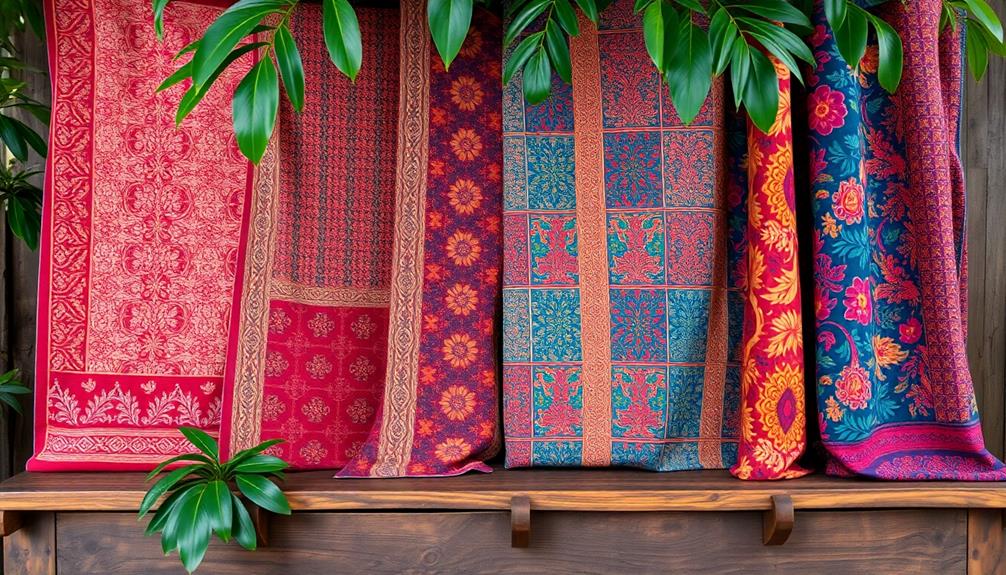
Indonesian textiles represent a vibrant tapestry of cultural heritage, showcasing the archipelago's diverse techniques and traditions. When you investigate these textiles, you'll encounter a plethora of traditional weaving methods, each telling its own story. Techniques like batik, ikat, and songket exemplify Indonesia's textile artistry, and much like the intricate designs of Indonesian Decor Masks, these textiles reflect the rich cultural narratives of the region.
Batik involves applying molten wax to fabric, creating intricate designs that are as beautiful as they're meaningful. Ikat, on the other hand, showcases pre-dyed threads, resulting in unique patterns that capture attention.
The National Gallery of Australia features over 1,200 pieces, reflecting Indonesia's rich diversity in textile craftsmanship. You'll find that textiles often serve ceremonial purposes and embody regional identities, with certain types like patola and songket symbolizing power and status within society.
Other techniques, such as appliqué, bead weaving, and mirror work, further enrich the artistic expression found in Indonesian textiles.
As you explore the world of Indonesian textiles, you'll appreciate the ongoing efforts in research and exhibitions aimed at preserving these traditional practices. This dedication not only enhances public access to their history but also promotes the continuation of these age-old techniques for future generations.
Cultural Significance and Heritage

Textiles in Indonesia are more than just beautiful creations; they embody the rich tapestry of cultural significance and heritage woven into the lives of various ethnic groups. Each piece, whether it's batik or ikat, reflects the unique traditions and beliefs of its community. The use of traditional textile techniques carries profound meanings, as many designs symbolize local rituals, historical narratives, and values.
These vibrant textiles often find their way into home decor, enhancing spaces with their intricate patterns and storytelling qualities, making them a perfect addition to Indonesian Decorative Pillows.
For instance, textiles like patola and songket have historically signified status and power, often reserved for aristocrats and ceremonial occasions. This highlights the connection between fabrics and social hierarchy, reinforcing their cultural significance.
Meanwhile, the sacred Geringsing textile from Bali exemplifies how spirituality intertwines with artistic expression, as it plays a key role in rituals.
As globalization threatens to dilute these practices, efforts to preserve traditional textile techniques and promote natural dye practices are essential for maintaining Indonesia's cultural identity.
Unique Weaving Techniques
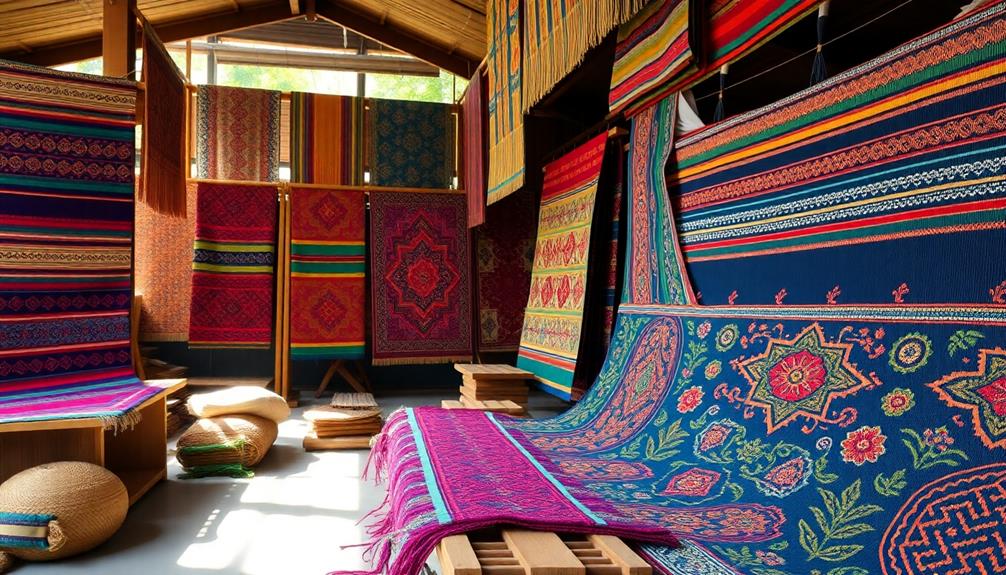
In exploring Indonesian textiles, you'll discover a variety of unique weaving techniques that showcase traditional craftsmanship.
Each region boasts its own variations, reflecting local cultures and artistry. For instance, the intricate patterns found in textiles often mirror the architectural styles of traditional Indonesian housing, adding another layer of cultural depth.
These techniques not only enhance the fabric's beauty but also highlight their deep cultural significance.
Traditional Techniques Overview
A rich tapestry of traditional techniques defines the artistry of Indonesia's textiles, showcasing unique weaving methods that reflect the country's diverse cultures. One of the most prominent techniques is Ikat, where threads are tied and dyed prior to weaving. This method creates intricate patterns, often resulting in reversible designs, especially in double ikat pieces.
These vibrant patterns are similar to those found in Indonesian Decor Masks, enhancing the cultural aesthetic of any space.
Batik stands out as another significant method, involving the application of molten wax to fabric. This technique allows for detailed designs through multiple waxing and dyeing processes, making each piece a unique work of art.
You'll also encounter Songket, which incorporates gold or silver threads, symbolizing status and wealth. This luxurious fabric is often reserved for ceremonial clothing, adding a touch of elegance.
Don't overlook Appliqué, where additional fabric pieces are stitched onto a base, creating decorative patterns that highlight regional artistry.
Finally, Tritik involves stitching and gathering fabric before dyeing, resulting in unique designs that reflect the cultural narratives and traditions of Indonesian communities.
Each technique tells a story, inviting you to explore the rich heritage embedded in these textiles.
Regional Variations Explored
Across Indonesia, you'll discover a wealth of regional variations in weaving techniques that showcase the country's rich cultural tapestry. One prominent method is ikat, where artisans tie and dye threads before weaving, creating intricate patterns that stand out in any woven fabric.
The patola technique, known for its double ikat process, adds a unique flair, reflecting a blend of influences across the region, often associated with high social status. These textiles not only embody artistic creativity but also represent the importance of Indonesian decor masks, illustrating the deep cultural narratives woven into each piece.
In the domain of opulence, songket textiles feature luxurious gold or silver wrapped threads. Historically worn by aristocracy, these fabrics boast elaborate designs that can elevate your interior design projects.
Meanwhile, Lampung's tampan and palepai textiles, made from hand-spun cotton, display intricate motifs of animals and ships, emphasizing the region's artistic heritage.
Borneo offers another layer of uniqueness with its vibrant wrapping techniques, showcasing cultural motifs that highlight the diverse artistic expressions of various ethnic groups.
Each of these techniques not only enhances the beauty of woven fabric but also serves as a reflection of Indonesia's rich cultural identity, making them perfect for your next design inspiration.
Cultural Significance Highlighted
Unique weaving techniques in Indonesian textiles do more than just create beautiful patterns; they embody the cultural stories and values of the regions they come from.
Take ikat, for example. This method involves tying and dyeing the warp threads before weaving, resulting in intricate designs that reflect the community's identity. The intricate patterns found in traditional Indonesian style home decor often utilize these textiles to enhance the aesthetic appeal of living spaces.
Double ikat is particularly revered for its complexity and reversibility, showcasing not just artistry but also deep cultural significance.
Batik employs a multi-step waxing and dyeing process to create detailed designs, often symbolizing local narratives and traditions.
Meanwhile, songket, with its shimmering gold or silver threads, marks status and is associated with the aristocracy, highlighting the artisans' mastery of supplementary weaving techniques.
The geringsing textile, a sacred double ikat from Bali, carries not only aesthetic value but also magical properties, often used in rituals.
Finally, bead weaving adds a decorative touch, enhancing the cultural significance of each piece by showcasing regional artistry.
Each technique, through its unique methods and materials, tells a story, connecting you to Indonesia's rich heritage while adding depth to your design choices.
Natural Dyes and Materials
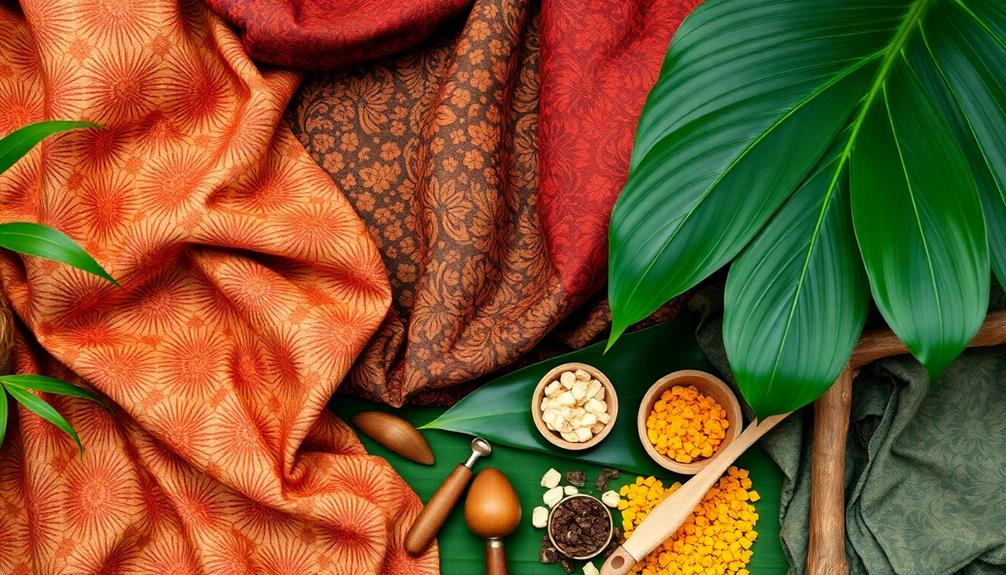
When you explore natural dyes in Indonesia, you'll discover a wealth of sustainable sources rooted in traditional techniques that often utilize local materials like bamboo and natural fibers.
These methods not only reflect the rich cultural heritage of various ethnic groups but also emphasize the importance of preserving regional identities, much like the community-oriented layouts seen in traditional Indonesian houses.
Sustainable Dye Sources
Natural dye sources in Indonesia not only serve functional purposes in textile production but also reflect the rich cultural heritage tied to local herbal health traditions and rituals. By tapping into sustainable dye sources, you can embrace eco-friendly practices that benefit both the environment and local communities. One notable example is Morinda dyeing, which utilizes the Morinda citrifolia plant to produce vibrant hues.
Here's a glimpse of some sustainable dye sources you might explore:
| Dye Source | Color Produced | Cultural Significance |
|---|---|---|
| Indigo | Blue | Used in ceremonial garments |
| Morinda | Red | Tied to healing rituals |
| Turmeric | Yellow | Symbol of purity and protection |
The diversity of raw materials across Indonesia's 17 ethnic groups showcases unique fermentation processes and cultural practices. However, the erosion of traditional techniques poses a threat to these sustainable practices. Emphasizing the use of bamboo fiber can further enhance sustainability, as it grows rapidly and aids in environmental restoration. By choosing these natural dyes, you contribute to preserving cultural heritage while promoting ecological responsibility in the textile industry.
Traditional Dyeing Techniques
Indonesian traditional dyeing techniques are deeply rooted in the country's rich biodiversity and cultural heritage. You'll find that artisans often use natural dyes sourced from local plants, minerals, and even insects. These vibrant colors not only enhance the aesthetic appeal of textiles but also connect to traditional herbal health practices, as certain plants are believed to possess medicinal properties.
The use of natural materials like bamboo and wood underscores the importance of sustainability in Southeast Asian decor. The fermentation processes for indigo dyeing, for example, vary greatly across regions, and these local practices influence the color intensity and quality of the dye produced. This regional diversity enriches the textiles, telling a story through color and technique.
However, cultural erosion threatens these traditional dyeing techniques, which is a pressing concern. If these artisanal skills and knowledge aren't preserved, future generations may lose an integral part of their heritage.
Additionally, the development of bamboo fiber as a textile material aligns with sustainable practices. Bamboo grows rapidly and can be processed into textiles, promoting environmental restoration.
Sustainable Fashion Practices

Sustainable fashion practices in Indonesia embrace a commitment to environmental health and cultural preservation. By prioritizing the use of natural dyes from local plants, these practices reduce reliance on synthetic chemicals that can harm waterways. This approach not only benefits the environment but also enriches the local culture, making it a reflection of the Balinese design characteristics that emphasize sustainability.
The integration of traditional weaving techniques, like ikat and batik, plays an essential role in sustaining cultural heritage while supporting local artisans. When you choose textiles that showcase these methods, you're promoting the use of locally sourced materials, which fosters community empowerment and economic stability.
Moreover, sustainable fashion focuses on quality and durability, minimizing waste and promoting a circular economy. This means that rather than discarding materials, they can be reused or recycled, which is fundamental in today's fashion landscape. As consumers increasingly prefer ethically produced garments, there's a significant shift towards recognizing the environmental and social impacts of fashion.
Strategic policies and support systems for artisans are critical in this movement. They guarantee that traditional methods are preserved while adapting to contemporary market needs, making sustainable fashion practices not only a responsible choice but also a culturally rich one.
Empowering Local Artisans

Empowering local artisans is essential for preserving Indonesia's rich textile heritage while fostering economic growth. By collaborating directly with artisans, you can help them master traditional weaving techniques like ikat through hands-on projects that span 4-7 days. This approach not only enhances their skills but also instills pride in their craft, much like the way Bohemian wedding decor intertwines natural elements with artistic expression.
Your involvement extends to supporting natural dye development, engaging with various ethnic groups to tap into community knowledge and local resources. This collaboration guarantees that traditional dyeing practices remain vibrant and relevant. Advocate for local fiber initiatives to combat the threats posed by imported cotton yarn, showcasing success stories that inspire communities to rally behind their artisans.
Moreover, by understanding customer aspirations, you can bridge the gap between modern markets and traditional craftsmanship. This design process guarantees artisans are integral to creating culturally significant textiles.
Integrating Textiles Into Design
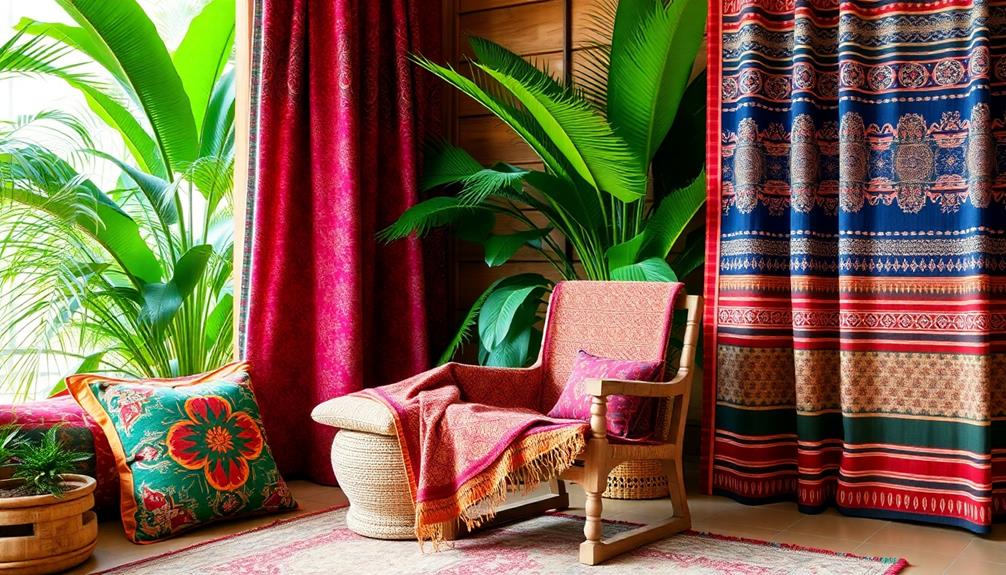
Textiles can transform a design project by infusing it with rich cultural narratives and unique aesthetics. By integrating Indonesian textiles like batik and ikat, you're not just adding patterns; you're weaving stories and traditions into your work.
The use of natural dyes, often derived from local plants, connects your designs to sustainable practices and herbal health traditions, giving them authenticity.
When you incorporate intricate techniques like supplementary warp and appliqué, you add tactile dimensions that elevate your design.
Here are some key benefits of integrating textiles into your projects:
- Cultural richness: Each piece tells a story, reflecting regional diversity and artistic expression.
- Sustainability: Natural dyes promote eco-friendliness and support local traditions.
- Luxury appeal: Textiles like songket, with their gold or silver threads, enhance visual allure for high-end markets.
- Craftsmanship appreciation: Highlighting artisans' skills fosters a deeper connection between consumers and the cultural heritage behind the textiles.
Trends in Indonesian Textile Design
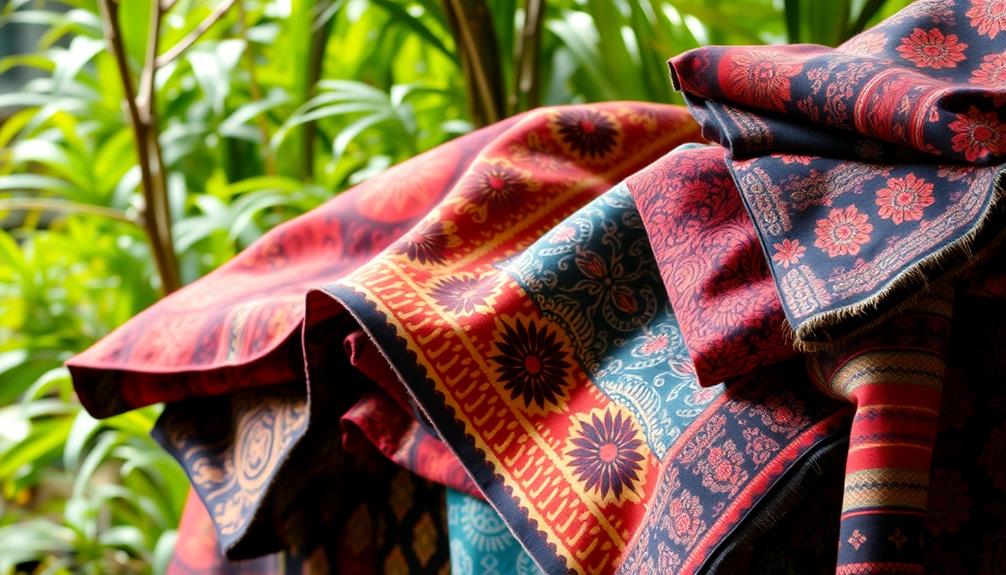
Indonesia's textile design scene is witnessing a vibrant evolution, as contemporary artisans blend traditional techniques with modern sensibilities. You'll find unique methods like batik, ikat, and songket that reflect the archipelago's rich cultural heritage.
A significant trend is the resurgence of natural dyeing practices, where artisans revive traditional methods using local plant materials to create eco-friendly textiles. Contemporary designers are making waves by merging traditional motifs with modern aesthetics, producing innovative textiles that cater to both local and international markets.
As you explore these designs, you'll notice that many emphasize sustainable materials, such as bamboo fiber and organic cotton. This shift towards environmentally-friendly production methods resonates with eco-conscious consumers.
Moreover, the patterns and designs often tell cultural narratives, with motifs symbolizing protection, prosperity, and identity. This makes Indonesian textiles not just visually stunning but also deeply meaningful.
Frequently Asked Questions
What Is the Indonesian Textile Technique?
Indonesian textile techniques include batik, ikat, and appliqué, each showcasing unique methods of dyeing and pattern creation. They reflect rich cultural traditions and craftsmanship, offering vibrant designs that you can incorporate into your own style.
What Is the Famous Fabric Design of Indonesia?
You won't believe how stunning Indonesia's Batik fabric is! It's famous for its intricate patterns crafted through a unique wax-resist dyeing method. You'll be captivated by the vibrant artistry and cultural significance woven into every piece.
How Do Cambodians Design Their Textiles?
Cambodians design their textiles by blending traditional techniques like silk weaving and ikat with modern aesthetics. You'll find vibrant colors from natural dyes, reflecting their rich heritage and empowering local artisans through fair trade practices.
How Big Is the Textile Industry in Indonesia?
You'll find Indonesia's textile industry flourishing, contributing about $13 billion to the economy. With around 3 million jobs, it weaves together cultural heritage and modern trends, making it a vibrant sector full of opportunity.
Conclusion
Incorporating Indonesian textiles into your design can truly transform your creations, adding depth and cultural richness. Remember, "beauty is in the eye of the beholder," and these vibrant fabrics offer a fresh perspective that can inspire your artistic vision. By embracing their unique heritage and supporting local artisans, you not only elevate your work but also contribute to sustainable fashion. So go ahead, explore these textiles and let them spark your creativity!










